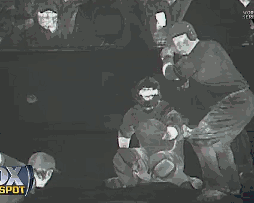Anyone watching Game 1 of the World Series last night saw the new toy Fox brought to the broadcast this year. An infrared imaging system – borrowed from cricket and called Hot Spot – was set-up in Busch Stadium to watch every pitch and record when and where the ball hit the bat (or the ground or the batter or…). Here's an animated clip from the broadcast. Note the angle at which the ball hits the bat and the exact spot on the heel that it hits Albert Pujols.

(Image from Baseball Nation)
The feature was used often at the start of the game, as Fox did their best to show us how cool the technology was. And it was pretty neat at first, giving us at home a new way to see the game, even if it didn't give us all that much information. "Oh look, the ball hit the bat right about where I thought it did from the normal video!" At least the gray-scale was pretty cool to look at.
If anyone missed Hot Spot's use early in the game, though, they certainly didn't miss it in the ninth inning when Texas' Adrian Beltre was called out at first after he fouled a ball off his foot. The ball only grazed Beltre by the slightest of margins, so it's understandable if the umpire thought that the ball hit nothing but dirt (though how he could think Beltre was faking his pain is beyond me). With Hot Spot, however, Fox was able to show the millions of viewers at home just how wrong the umpire's call was, as the infrared technology clearly showed the slightest of heat marks on the tip of Beltre's shoe, evidence that he did indeed get hit by the ball. Watch:
The Rangers didn't benefit from the new technology, but we viewers certainly did. Nice work, Fox.
If you think about it, though, Fox got really lucky Wednesday night. The Beltre play was just about the most perfect use of Hot Spot that the network could dream of. It was an important, high-pressure situation involving a star player that happened to show everyone exactly why the use of infrared technology might be important. It was a very lucky break.
It makes me wonder, though: other than the very rare instances when a player will foul a ball off his body that the umpire doesn't notice, is there anything else that we could use Hot Spot for? There are those few at-bats a year when an umpire seems to have a different opinion than the batter on whether a pitched ball hit him or not, but that's hardly different than the Beltre situation. Are there any other uses?
There's only one really good use I can think of, and I'm not even sure how great it would work. Let's say that, in back-to-back innings, Pujols crushes a ball deep into the leftfield bleachers off an inside-fastball and then Nelson Cruz hits a nearly identical inside-fastball to deep leftfield only to have the ball die at the warning track. The pitch speeds and locations were the same and the weather hadn't changed. In that situation, Fox might be able to give us a side-by-side view of Pujols' and Cruz's swings and show us exactly how the ball came off the bat. Maybe, for example, Pujols connected with the ball with the bat's sweetspot while Cruz missed it by a quarter-of-an-inch. It's not something that we would be able to see at home regularly, but it could go a long way in explaining to the public how even the slightest variables can drastically affect a game.
Does anyone else have any ideas on how this kind of technology might be used in a baseball game? I suppose it could help with home run calls, but only if the cameras were used around the stadium. It seems like a pretty cool thing, but I'm not sure it could ever be used for anything relevant to baseball.
Thank you for reading
This is a free article. If you enjoyed it, consider subscribing to Baseball Prospectus. Subscriptions support ongoing public baseball research and analysis in an increasingly proprietary environment.
Subscribe now
Swing & Miss vs. foul tip to determine dropped third strike or passed ball/wild pitch
Incidentally, I find it interesting that the video clips available at MLB.com now describe that pitch as one where Berkman is taking exception to a, quote, "called strike." Interesting euphemism for "ump screwup on a foul-tip call", don't you think? Because that's not only the way it looked at the time, it's the way MLB originally described the video.
How are they using it for cricket?